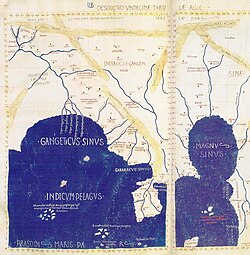
Back গংগাঋদ্ধি Assamese গঙ্গাঋদ্ধি Bengali/Bangla Gangaridaj Esperanto Gangaridai French गंगाऋद्धि Hindi Gangaridák Hungarian Gangaridai ID Gangaridai Italian ಗಙ್ಗಾಋದ್ಧಿ Kannada 강가리다이 Korean
Gangaridai | |
|---|---|
| c. 300 BCE[1]–c. 2nd century CE [2] | |
 Ptolemy's Geography, depicting India beyond the Ganges | |
| Capital | Wari-Bateshwar or Chandraketugarh[1] |
| Government | Monarchy [citation needed] |
• King | Xandrames - After the establishment of the Nanda Dynasty |
| History | |
• Established | c. 300 BCE[1] |
• Disestablished | c. 2nd century CE [2] |
| Today part of | |
Gangaridai (Greek: Γαγγαρίδαι; Latin: Gangaridae) is a term used by the ancient Greco-Roman writers (1st century BCE-2nd century AD) to describe people or a geographical region of Bengal in the ancient Indian subcontinent. Some of these writers state that Alexander the Great withdrew from the Indian subcontinent because of the strong war elephant force of the Gangaridai.[1]
A number of modern scholars locate Gangaridai in the Ganges Delta of the Bengal region, although alternative theories also exist. Gange or Ganges, the capital of the Gangaridai (according to Ptolemy), has been identified with several sites in the region, including Chandraketugarh and Wari-Bateshwar.[3]
- ^ a b c d "Gangaridai - Banglapedia". en.banglapedia.org. Retrieved 28 February 2022.
- ^ "The Historic State of Gangaridai". Bangladesh.com. Archived from the original on 24 December 2024.
- ^ "History". Banglapedia. Archived from the original on 29 September 2017. Retrieved 23 September 2017.
Shah-i-Bangalah, Shah-i-Bangaliyan and Sultan-i-Bangalah